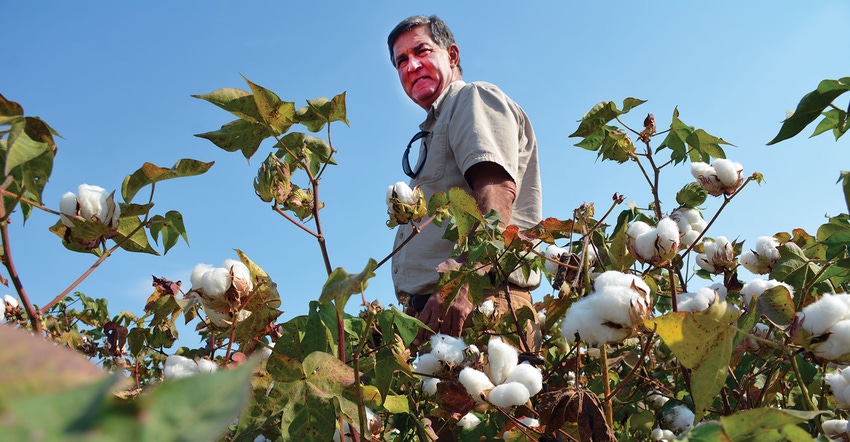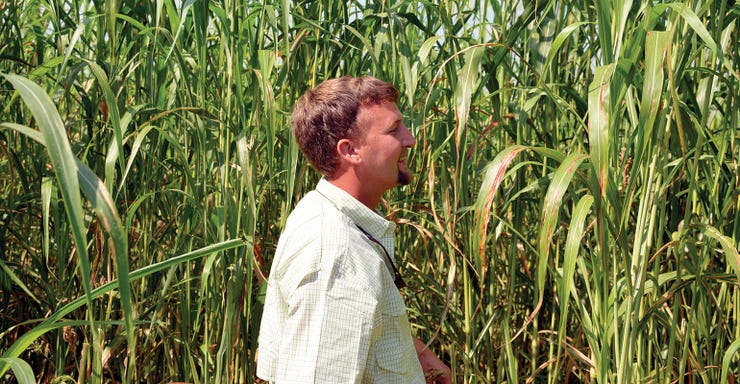
Despite some early season setbacks, including delayed and prevented planting, west Tennessee cotton farmers are preparing to harvest what looks to be a good crop, if they can get open weather to pick it.
Wet weather, including flooding in some bottomlands, prevented farmers from planting cotton on thousands of acres. Others were delayed by persistent rainfall that began last fall and continued into August.
“We had an interesting year,” says John Lindamood, who farms near Tiptonville in Lake County, Tenn. Lindamood says flooding prevented them from planting some acres and other wet weather issues created a few setbacks, but he stops well short of complaining.
“Farmers in Arkansas and the Midwest had it much worse than we did,” he says. “We’ve had some challenges, but not of the magnitude they had.”
He says “incessant rains started last fall and continued week after week. By this August, we had received 100 percent of our annual rainfall.” Lake County lies in the northwest corner of Tennessee, bordered by the Mississippi River and the Kentucky state line.
Last year’s wet fall and soggy harvest season left a lot of fields rutted, Lindamood says. “We expected to do a lot of field work to prepare for planting, but it rained so much the soil sort of healed itself. We were able to get the crops in without an excessive amount of tillage.”
They got some cotton planted on time, the last week of April, but some was delayed until the first week of June.
“We have about 15 percent (500 acres) of the crop open (Sept. 17). The rest will be spread out over several weeks, but we can’t pick it all at one time anyway. We got all but 200 of our intended cotton acres planted.”
He says bottomland, behind the levees, flooded. “On that flat topography and Delta-type soils, it doesn’t take but a little water to back up and spread out over a big area.”
He says many farmers were prevented from planting a lot more than that.
“On those prevented planting acres, we’ll just keep the weeds down. We’ll disk it. We have some resistant grass, so we will deep till, about 10 inches deep, and cut the tubers.”
He adds that they probably needed to do some drainage work on some of those fields anyway. “We will make lemonade. This is a good opportunity to do some drainage work.”
Lindamood says he’s disking those fields about once every three weeks to keep pigweeds down.
A late August and early September dry spell also poses a problem for cotton. “Conditions were so wet early, Lindamood says, “cotton didn’t develop a taproot. The soil dries out in the top 6 inches and the plant has no way to get moisture. Effect on yield is a question.”
He says the lack of a taproot also affects nutrient uptake. “Some varieties and the lack of a taproot may promote a potassium deficiency. A good rain can bring it back to life.”
He says some of the droughty cotton may be difficult to defoliate. “The other cotton looks good. We are so much better off than folks in the Midwest.”

Prevented Planting
Andy Zarecor
Andy Zarecor, 30, who farms with his father, Mack, 58, near Yorkville, Tenn., anticipates a good cotton crop.
“It looks excellent,” he says. “It was hard to get planted; this May was one of the wettest I’ve ever experienced.”
That prolonged wet spell prevented the Zarecors from planting 400 of their anticipated 1,000-acre cotton crop. “We started in April and got rained out after we planted 250 acres. We planted a little more on time, but the first three weeks of May we had rain about every three days. We were not flooded, just too wet to plant.”
Zarecor says the later cotton, with ample moisture and plenty of heat, caught up quickly. “We will not know how good it is until we get the picker in it.”
He had just defoliated his first field in mid-September. “We’re not seeing much difficulty with defoliation. The later planted cotton is only about 10 days behind the fields we planted on time.”
He says the prevented planting acreage, in light of current cotton prices, could have been “a blessing in disguise not to have it in cotton.”
He took prevented planting insurance on most of those acres but rotated some to soybeans.
“We left the prevented planting acres fallow and planted cover crops. We will see an immediate benefit from the cover with suppressed pigweed.”
They planted a mix of Sudan, millet and cowpea. The Sudan stands more than head high. “We will get a lot of organic matter from the cover crop,” he says.

uckey
Jason Luckey
A few miles down the road from Zarecor, in Humboldt, Tenn., Jason Luckey says the cotton crop looks really good, but says he’s hesitant to mention it. “It seems like the best crops always come when you ask yourself at harvesttime, ‘where did that come from?’”
Luckey had just defoliated his first field Sept. 18. “I like to wait two weeks after defoliation before I pick,” he says.
In spite of early weather, Luckey says, “We are blessed in this area. We started planting April 30 and did not go a week without the weatherman calling for rain.”
He says he would start to plant and then would back off, waiting for rain to hold up, but most of those rain events were minimal, about a tenth of an inch. “If we had planted, it would have been perfect. Still, we wrapped up on May 25, right in the window.”
He says rain has been consistent. “From October [2018] through Aug. 24, we have gone no more than seven days without measurable rain.”
A cold spell may have hurt, too.
“The first few days of June we had three nights with temperatures in the high 40s. Some two-week old cotton had pythium and was stunted. I just walked 200 acres of cotton with a consultant and it looks to be average.
“We are also cutting one of our best corn crops; one field is yielding more than 230 bushels per acre and 179 bushels has been our worst. That’s all dryland corn. We’ve had timely rains on corn.”
A dry September has been good for corn harvest. “We’ve been dry now for three weeks,” Luckey says. “I would like a little shower on the late cotton to fill bolls. It would also help the defoliants work better. I don’t like to spray on droughty cotton.” He adds that defoliants do work well in hot weather.
He doesn’t think a rain now would increase yield significantly, “but I’d like to get one more rain.”
He expected to start harvesting cotton Sept. 30. “I may start the 26th or 27th if everything looks great.”
He and other west Tennessee cotton farmers will spend a few days prepping for harvest. Luckey says he’ll defoliate and then turn to harvester maintenance.
“It’s been a good year,” he says. “Plant bugs have been light. We didn’t even have to spray some fields. We had no late stink bugs. Not sure why.
“So, it’s been a good season except for a couple of glitches — those cool nights in June that set cotton back but helped the corn, and the remnants of Hurricane Barry.”
Across the region, conditions vary. Some dodged the inundation from the hurricane; some managed to plant most of their acreage on time or close to it; prevented plantings range from hundreds of acres to just a few fields in the bottomlands.
“We just have to play the hand we’re dealt,” Zarecor says.
About the Author(s)
You May Also Like






